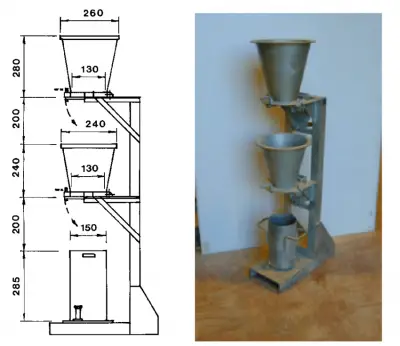Compaction Factor Test for Concrete Workability.
General
The compacting factor test process has an element of external force in it, compared to the slump test. This test measures the compactability of concrete, depending upon the external force application.
The compacting factor is defined as the ratio of the weight of partially compacted concrete to the weight of fully compacted concrete.
The test shows better results for concrete of low and medium workability (compacting factor of 0.9 to 0.8). The test is suitable foe laboratory environment.
Slump, Vee Bee, and Compaction Factor test results are compared below:
Workability Test Results Compared | |||
Workability Degree | Slump test(mm) | Vee Bee Test(seconds) | Compaction Factor Test (number) |
Very Low | 0 – 25 | 20 – 10 | 0.78 |
Low | 25 – 50 – 5 | 10 – 5 | 0.85 |
Medium | 50 -100 | 5 – 3 | 0.92 |
High | 100 – 150 | 3 – 1 | 0.95 |
For concrete of very low workability of 0.70 or below, the test is not suitable, because more external efforts are required for such concrete.
Apparatus for Compaction Factor test and Degree of Workability
The Compaction Factor Test apparatus as shown above includes:
Container — (for degree of compatibility test) having followed dimensions:
a) Base : 200 ± 2 mm × 200 ± 2 mm
b) Height : 400 ± 2 mm
c) Thickness of the base and walls shall be at least 1.5 mm
Ordinary trowels,
One scoop of adequate size,
Tamping rod made of steel, having a circular cross-section with a diameter of 16 ± 1 mm, 600 ± 5 mm in length and with rounded ends,
Measuring scales (or a balance) to weigh up to 50 kg, with an accuracy to the nearest 10 g.
Compaction Factor Test apparatus as shown above.
Procedure for Compaction Factor Test for Concrete
Clean the hoppers and cylinder and dampen the inside of the hopper and cylinder with a moist cloth before its use. Find th weight of empty cylinder (W1).
The sample of concrete collected to the specification shall be placed gently in the upper hopper, to fill it completely up to the top of hopper, with its trap door closed.
Close the trap door of bottom hopper. Open the trap door of the upper hopper so that the material falls into bottom hopper
Next open the trap door of the bottom hopper and allow th concrete to fall into the cylinder.
Measure the weight of the cylinder plus concrete. Let it be known as the weight of partially compacted concrete. (W2)
Refill the cylinder with the same sampl in laye
approximately 5 cm deep, with ramming for full compaction.
The weight of the concrete in the cylinder shall then be determined to the nearest 50 g. This weight shall be known as the weight of fully compacted concrete. (WCompaction Factor is calculated as below:
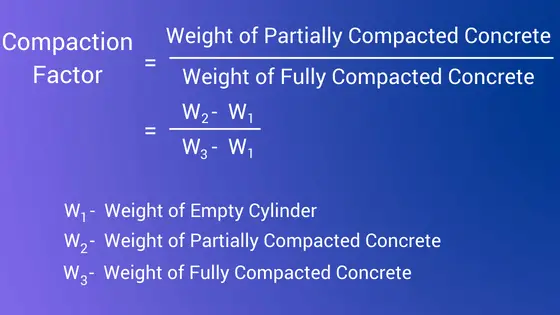
The degree of workability and their compacting factor are as follows:
(CF) is 0.78 – it is considered as very low workability of concrete,
(CF) is 0.85 – it is considered as low workability of concrete,
(CF) is 0.92 – it is considered as medium workability of concrete,
(CF) is 0.95 – it is considered as high workability of concrete.
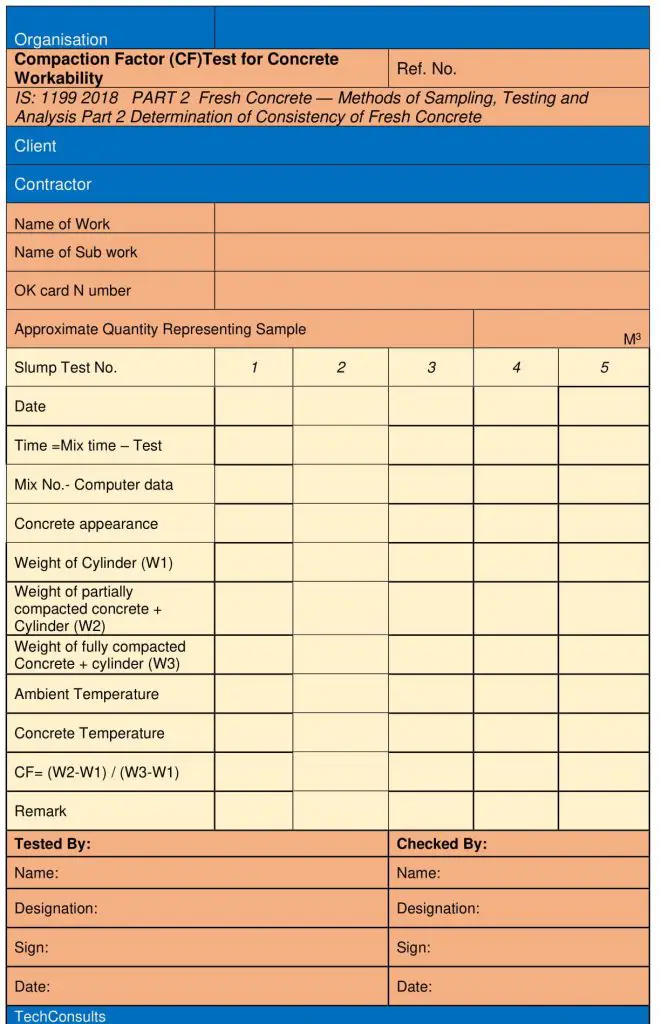
Degree of Compactability of Fresh Concrete
Principle -The fresh concrete is uniformly placed with trowel in a container with specifications given above, avoiding any compaction while filling. When the container is full, the top surface is scraped in level with the top of the container. At this stage, the height of concrete as shown figure is = h1
The concrete is, refilled in the container in layer of 5 cm and fully compacted. The distance from the surface of the compacted concrete to the upper edge of the container (h2) is used to define the degree of compactability.
The degree of compatibility = h1/(h1 – h2)
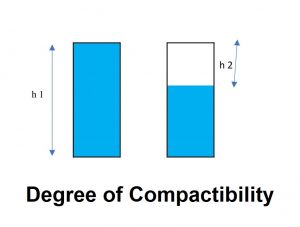
The values lying between 1.04 and 1.46. If the degree of compactability is less than 1.04 or more than 1.46, this test is not suitable.
Procedure to find the Degree of compactability of Concrete.
a) Clean the container and dampen the inner surfaces using a moist cloth.
b) Fill the container without tamping it, with the trowel up to all four upper edges of the container. When the container is full, remove all concrete above upper edges, using straight edged scrapper .
c) Refill the concrete in layers and compact it by means of tamping rod / vibrator, until no further reduction in volume is determinable.
d) After compaction, measure to the nearest millimetre, the distance between the surface of the compacted concrete and the upper edge of the container at the middle of each side of the container.
e) Determine the mean value of the four measurements.
The degree of compactability is given by equation:
c = h1 / (h1 – h2) where c = degree of compactability
Workability Tests Compared for Concrete
Suggested Workability Tests | |
Workability Degree | Vee Bee |
Very Low | Vee Bee (VB); Compaction Factor (CF) |
Low | VB; CF; Slump Test |
Medium | CF; Slump Test; |
High | CF; Slump Test; Flow Test |
Very High | Flow Test |
Degree of Compactability Test Format
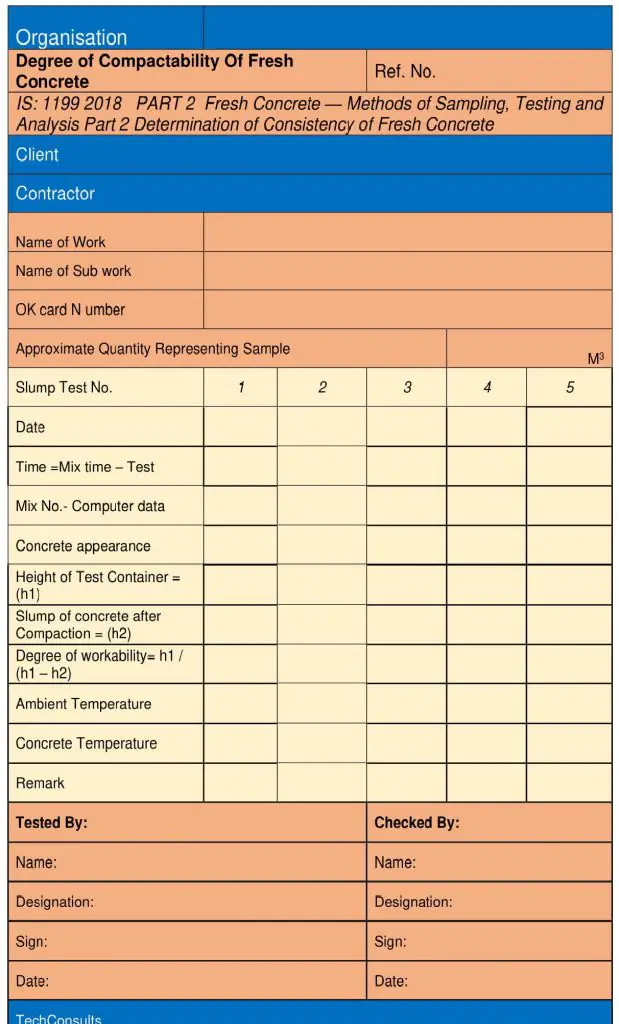
© All Rights Reserved 2020


